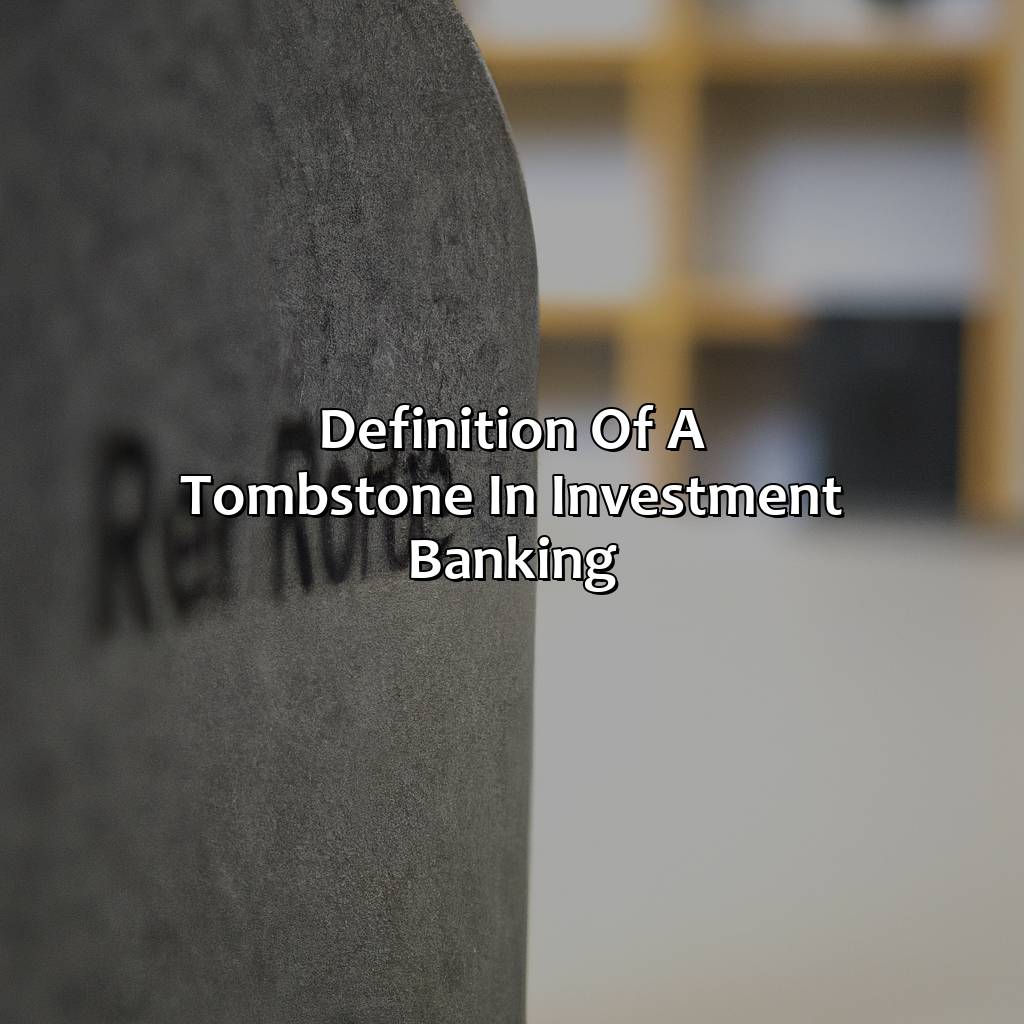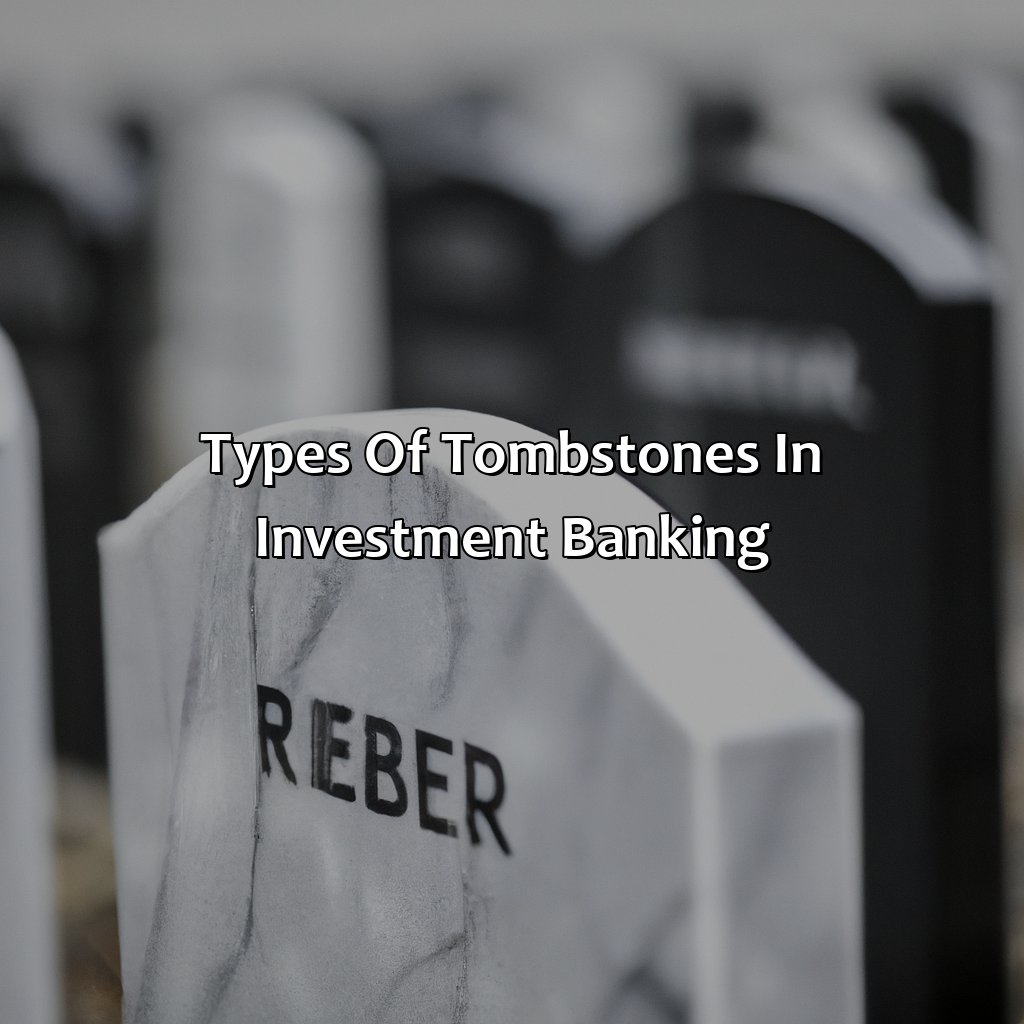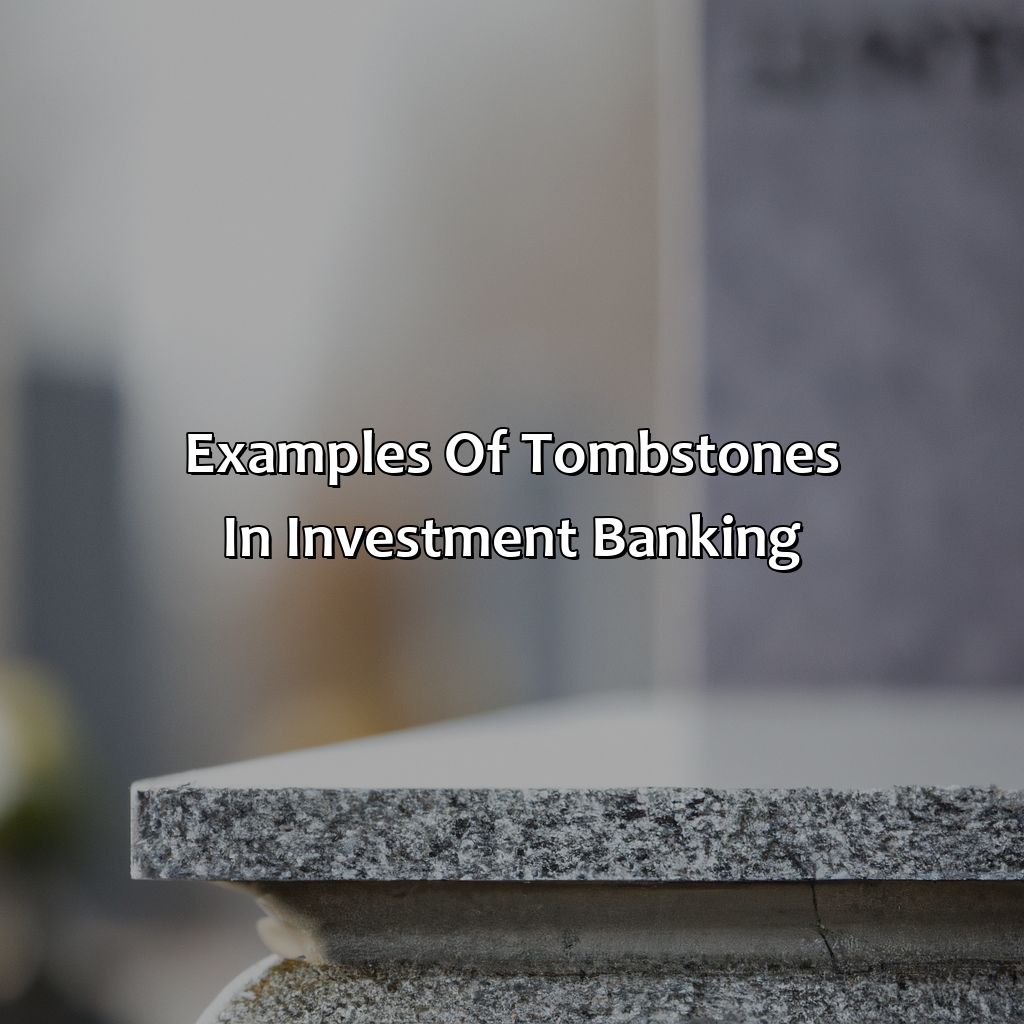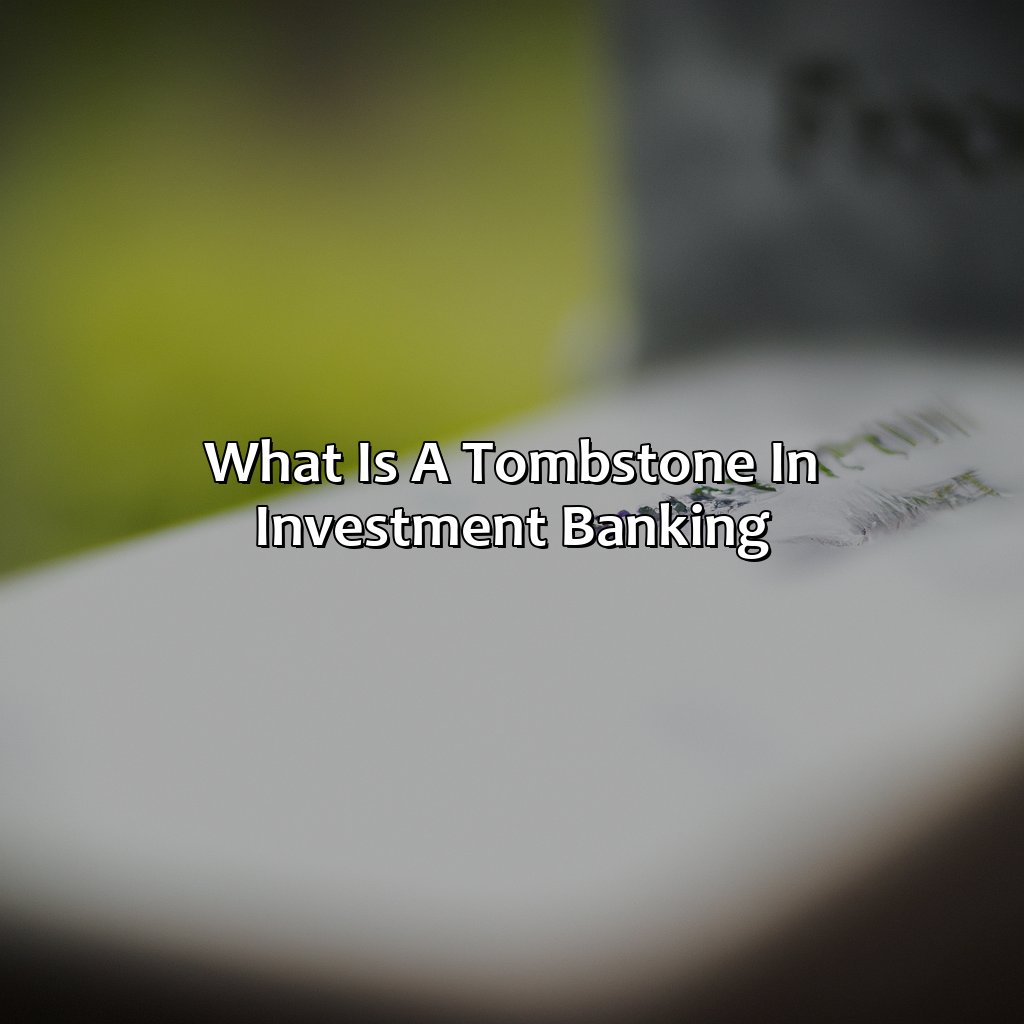What Is A Tombstone In Investment Banking?
Key Takeaways:
- A tombstone in investment banking is a type of advertisement used to announce the completion of a financial transaction, such as an initial public offering (IPO) or M&A deal. It includes key details about the transaction, such as the names of the parties involved and the deal size.
- A tombstone is an important marketing tool for investment banks and can help attract potential clients by showcasing their expertise in completing complex financial transactions. They also serve as a way to recognize the hard work and achievements of those involved in the deal.
- The design and content of a tombstone is critical to its effectiveness. It should be visually appealing and easy to read, with all necessary information clearly displayed. Investment banks may work with graphic designers to create a unique and memorable tombstone.
Do you want to know what a tombstone in investment banking is? Are you in the financial services sector and need to understand what a tombstone is? This article explores the concept of investment banking tombstones and why it is important. You’ll get a better understanding of this mysterious term and how it can help in financial decision-making.
Definition of a Tombstone in Investment Banking
Tombstones in investment banking refer to printed advertisements that announce a completed financial transaction. These ads are usually placed in financial newspapers, depicting the details of the deal, such as the name of the parties involved, the nature of the transaction, and the value of the deal. Tombstones serve as a means of public relations for investment banks that have engaged in transactions that are worth touting. They are an endorsement of the expertise and credibility of the investment bank. Tombstones also serve as a record of the deal that can be used for future reference.
Tombstones typically come in black and white and contain a simple design and text. These ads are an effective marketing tool for investment banks as they create a buzz around the completed transaction. They portray the investment bank’s strengths and highlight their capability in handling large and complex deals. Tombstones are widely used in investment banking and are often collected by finance professionals as mementos.
It is interesting to note that the term “tombstone” refers to the engraved slabs of stone that are used as a memorial for the dead. As in a tombstone, the investment bank memorializes the completed transaction, the parties involved and the value of the deal. Tombstones are also called deal toys or Lucite tombstones, as Lucite is a common material used for making them.
According to a report by market research firm Technavio, the global tombstone market is expected to grow at a CAGR of over 18% from 2019-2023. This growth is attributed to the increasing number of M&A transactions that are driving the demand for tombstones in the investment banking sector.

Image credits: retiregenz.com by Harry Woodhock
Importance of a Tombstone in Investment Banking
Investment Banking Tombstones: A Professional Marker of Success
Tombstones in investment banking are highly important as they are a demonstration of a bank’s successful transactions. These markers of excellence are typically awards or plaques used to signify a closed deal. Tombstones are not only physical representations of success, but they also act as promotional tools for the banks that use them.
The importance of these markers lies in their ability to showcase the bank’s achievements to potential clients and investors, helping to build trust. This recognition serves as a testament to the expertise, resources, and hard work that went into closing each deal.
Unique details of Tombstones include their design, which can hold a vast range of information, including the names of the banks involved, date of closure, and deal value. They are often made of high-quality materials such as crystal, glass, or marble and are generally personalized for the specific deal.
One reliable example of the significance of Tombstones in investment banking is the story of the acquisition of Wyeth by Pfizer in 2009, which resulted in the creation of one of the world’s most distinguished global pharmaceutical companies. The Tombstones created to mark this achievement showcased the two banks’ expertise, professionalism, and ability to close the deal efficiently, ultimately building a foundation of trust for future deals.

Image credits: retiregenz.com by Harry Arnold
Design and Content of a Tombstone in Investment Banking
A tombstone in investment banking is a document that commemorates a recent transaction or deal. It typically lists the parties involved, transaction details, and sometimes a visual representation of the transaction. The design and content of a tombstone can vary depending on the transaction and the company’s branding guidelines. The document must be professional and informative, conveying the success and value of the transaction.
The content of a tombstone can include information such as the name of the transaction, the date it closed, the amount involved, and the parties involved. Visual aids such as graphs and charts can also be included to highlight key metrics. The design should be simple and clean, with a focus on the content. The use of color, typography, and images should follow the company’s branding guidelines.
To make the tombstone unique, companies can personalize the design and content based on the transaction’s specifics. For example, they could include a custom logo or graphic that symbolizes the transaction or add a brief statement from the CEO regarding the success of the deal.
When constructing a tombstone, it’s important to remember the audience. Investors, shareholders, and potential clients may all view the document, so the content should be directly relevant to them. Including a clear call to action can help direct them to further engage with the company.

Image credits: retiregenz.com by Yuval Duncun
Types of Tombstones in Investment Banking
In the world of investment banking, the term that refers to commemorating a successful financial deal is known as a tombstone. A tombstone is an advertisement put together by an investment bank to celebrate a completed transaction or service offered to a client. The advertising material is a testament to the financial expertise of the bank. It is an essential way to market the investment bank’s services to the public.
Below is a table describing the different types of tombstones in Investment Banking:
| Type of Tombstone | Description |
|---|---|
| M&A Tombstone | Highlights a successful merger and acquisition (M&A) transaction that an investment bank facilitated. |
| Bond Tombstone | Outlines a bond transaction where a specific bond was brought to market to secure financing for a client. |
| Equity Tombstone | Celebrates the completion of a successful equity offering by the investment bank. |
| Syndicated Loans | Showcases the successful underwriting of a syndicated loan facility to raise capital for a client. |
| IPO Tombstone | Commemorates the successful initial public offering (IPO) of a company that the investment bank guided. |
Aside from being an investment banker’s marketing tool, tombstones are valuable mementos of successful deals that have helped foster relationships with clients. While it may not seem like much, the memento can make clients feel appreciated and entrenched in a real partnership with the investment bank.
A famous story about a tombstone dates back to the late 1960s, when an investment bank’s founding partner noticed that a client overlooked the tombstone tribute on their desk while they were negotiating a new deal. The partner called off the deal, realizing the client did not appreciate the effort that went into the finished product. This little anecdote highlights the value of a tombstone and how it can help build a relationship with clients.

Image credits: retiregenz.com by David Jones
Examples of Tombstones in Investment Banking
Investment bankers use tombstones as a way of commemorating their significant financial accomplishments. These are typically issued in the form of a press release or a printed advertisement featured in well-known newspapers or financial publications. Here are some examples:
| Company | Deal | Value (in billions) |
|---|---|---|
| Goldman Sachs | Facebook IPO | 16.0 |
| JP Morgan | AT&T-Time Warner merger | 86.0 |
| Morgan Stanley | Alibaba IPO | 25.0 |
It is worth noting that tombstones often feature the names of the Investment Bankers responsible for the deal, providing a degree of recognition and prestige. Interestingly, tombstones are not always traditional printed materials, and in today’s increasingly digital world, they can also be virtual memorials on websites or social media. This has allowed Investment Bankers to adapt to a rapidly changing market and showcase their digital capabilities.
A notable tombstone from history is the Pfizer-McPherson merger of 1928, which was foretold by a Broadway advertisement well before the deal was struck. The success of this transaction catapulted both companies to new heights and set a precedent for the tombstones we see today.
These examples serve to highlight the significance of tombstones in the world of Investment Banking, and their use as a way of commemorating the significant financial victories of bankers.
Image credits: retiregenz.com by Yuval Washington
Five Facts About Tombstones in Investment Banking:
A tombstone is a document used in investment banking to announce a completed transaction. (Source: Investopedia)
Tombstones typically include the names of the companies involved in the transaction, the nature of the transaction, and the financial terms. (Source: Wall Street Oasis)
Tombstones are primarily used for Mergers and Acquisitions, debt financing, and securities offerings. (Source: Corporate Finance Institute)
The term “tombstone” originated from the physical document resembling a grave marker and was traditionally made of black marble. (Source: The Street)
Tombstones are also used as a marketing tool for investment banks to showcase their successful transactions and attract future clients. (Source: MergerWare)
FAQs about What Is A Tombstone In Investment Banking?
What is a tombstone in investment banking?
A tombstone in investment banking refers to a printed advertisement or notice that contains details about a public offering or stock issuance. These notices typically provide details about the issuer of the security or the investment bank involved in the offering.
What is the purpose of a tombstone in investment banking?
The purpose of a tombstone in investment banking is to provide information about a public offering or stock issuance to potential investors. It is also used to generate interest and publicity for the security being offered.
What are some common features of a tombstone in investment banking?
Some common features of a tombstone in investment banking include the name of the issuer, the number of shares being offered, the price per share, the name of the investment bank involved in the offering, and the date of the offering.
How is a tombstone in investment banking different from a prospectus?
A prospectus in investment banking is a legal document that provides detailed information about a security being offered. It contains information about the issuer, the securities being offered, the terms of the offering, and the risks associated with investing in the security. A tombstone, on the other hand, is a printed advertisement or notice that provides a summary of the offering.
Are tombstones in investment banking required by law?
Tombstones in investment banking are not required by law. However, they are a common way to advertise and promote a public offering or stock issuance.
Who creates tombstones in investment banking?
Tombstones in investment banking are typically created by the investment bank involved in the offering. The investment bank may work with the issuer of the security to determine the content of the tombstone and to ensure that all necessary information is included.
 Checkout this IRS Loophole
Checkout this IRS Loophole 
